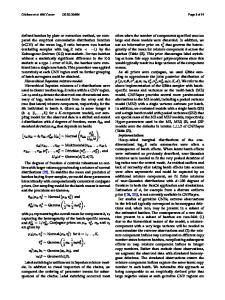Dispersion Number Studies in ChemicalMechanical Planarization
- PDF / 91,781 Bytes
- 5 Pages / 612 x 792 pts (letter) Page_size
- 94 Downloads / 336 Views
F5.2.1
Dispersion Number Studies in Chemical Mechanical Planarization Ara Philipossian and Erin Mitchell Department of Chemical and Environmental Engineering The University of Arizona Tucson, AZ 85721 USA ABSTRACT This study explores aspects of the fluid dynamics of CMP processes. The residence time distribution of slurry under the wafer is experimentally determined and used to calculate the Dispersion Number (∆) of the fluid in the wafer-pad region based on a dispersion model for non-ideal reactors. Furthermore, lubrication theory is used to explain flow behaviors at various operating conditions. Results indicate that at low wafer pressure and high relative pad-wafer velocity, the slurry exhibits nearly ideal plug flow behavior. As pressure increases and velocity decreases, flow begins to deviate from ideality and the slurry becomes increasingly more mixed beneath the wafer. These phenomena are confirmed to be the result of variable slurry film thicknesses between the pad and the wafer, as measured by changes in the coefficient of friction (COF) in the pad-wafer interface. INTRODUCTION Understanding the extent of flow non-idealities during CMP will become even more critical for maintaining stable and predictable processes as film thicknesses continue to decrease and wafer sizes continue to increase in accordance with ITRS [1]. Previous research indicates that slurry distribution under the wafer significantly influences the process [2-4]. Despite a wide consensus that slurry transport is critical, limited experimental research has been performed on slurry flow under the wafer. In this work, the space bounded between the wafer and the pad is treated as a reaction chamber (much like those considered in theoretical chemical reactor design & analysis) with its own slurry input and output streams. This study strives to develop a greater understanding of fluid dynamics by using lubrication theory and the residence time distribution (RTD) technique to determine the vessel Dispersion Number (∆) at a variety of operating parameters. By employing classical RTD techniques coupled with well defined vessel dispersion models for non-ideal reactors, the extent of axial dispersion as function of slurry flow rate, wafer pressure, and pad-wafer velocity are quantified. APPARATUS A fully automated scaled version of a Speedfam-IPEC 472 polisher was used in this study. The polisher resides on a novel sliding table that measures the frictional force in the pad-slurry-wafer interface. The friction table is synchronized to the polisher such that real-time friction data – crucial for determining the RTD – can be obtained. For any given run, the coefficient of friction (COF) is determined by taking the ratio of shear force to normal force. The apparatus is described in greater detail elsewhere [5]. THEORY The dispersion model is used to describe non-ideal reactors, where the axial dispersion is superimposed on fluid plug flow. ∆ is defined as: ∆=
D v× L
(1)
Downloaded from https://www.cambridge.org/core. The Librarian-Seeley Historical L
Data Loading...











